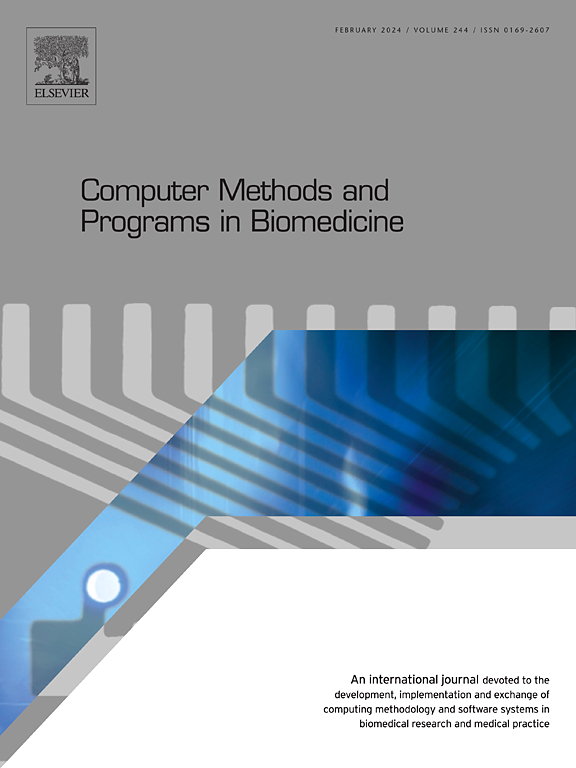Human-computer interaction on virtual reality-based training system for vascular interventional surgery
IF 4.9
2区 医学
Q1 COMPUTER SCIENCE, INTERDISCIPLINARY APPLICATIONS
引用次数: 0
Abstract
Background and objective
Currently, precision control and interaction between virtual hand models and ultrafine, ultra-long flexible guidewires in virtual vascular interventional surgery training systems still remain challenging.
Methods
To tackle this issue, this study utilized a hybrid approach combining Cosserat rod theory with quaternions to develop a model for ultra-long flexible guidewires. Through the implementation of a spatial hash-based continuous collision detection (CCD) algorithm, the system achieved precise collision detection between the guidewire and blood vessels. Additionally, adhesive collision particles were integrated into the fingers of the virtual hand model involved in interactions, facilitating the simulation of intervention tasks such as grasping and delivering. CCD technology, in conjunction with extended bounding volume, was employed in the blood vessel model to prevent tunneling effects resulting from rapid hand manipulations.
Results
Experiments were conducted to assess the picking, delivery, and consistency of delivery distance, showcasing the alignment of manipulation between the virtual hand models and real hands when handling the guidewire. The virtual hand model successfully navigated the flexible guidewire model into vessels curved at angles of 30°, 60°, 90°, and 120°, achieving an average response time of 12.64 ms. Moreover, across vessel models curved at various angles, the average disparity between the delivery distance along the x-axis by the hand in a real environment and the guidewire's delivery distance within the virtual vessel model was approximately 3.71 mm, showcasing a high level of smoothness and stability in the interaction between the hand model and the guidewire model.
Conclusions
Finally, within the virtual system, the successful navigation of the hand delivering the guidewire through the femoral artery and radial artery towards the heart further demonstrates the excellent interaction performance between the virtual hand model and the ultrafine, ultra-long flexible guidewires. This success provides both theoretical and experimental support for the interactive training of virtual hand models and guidewires within virtual surgical training systems.
基于虚拟现实的血管介入手术训练系统的人机交互
背景和目的目前,在虚拟血管介入手术培训系统中,虚拟手部模型与超细、超长柔性导丝之间的精确控制和互动仍具有挑战性。方法为了解决这一问题,本研究采用了一种结合科塞拉特杆理论和四元数的混合方法来开发超长柔性导丝模型。通过实施基于空间哈希的连续碰撞检测(CCD)算法,该系统实现了导丝与血管之间的精确碰撞检测。此外,还在参与互动的虚拟手部模型的手指上集成了粘性碰撞颗粒,从而促进了抓取和递送等干预任务的模拟。在血管模型中采用了 CCD 技术和扩展边界体积,以防止因快速手部操作而产生的隧道效应。结果实验评估了取物、递送和递送距离的一致性,展示了虚拟手部模型和真实手部在处理导丝时的操作一致性。虚拟手模型成功地将柔性导丝模型导入弯曲角度为 30°、60°、90° 和 120°的血管中,平均响应时间为 12.64 毫秒。此外,在不同角度弯曲的血管模型中,真实环境中手部沿 x 轴的输送距离与虚拟血管模型中导丝输送距离之间的平均差距约为 3.71 毫米,这表明手部模型与导丝模型之间的交互具有高度的平滑性和稳定性。结论最后,在虚拟系统中,手通过股动脉和桡动脉将导丝送至心脏的成功导航进一步证明了虚拟手模型与超细、超长柔性导丝之间出色的交互性能。这一成功为虚拟手术培训系统中虚拟手部模型和导丝的互动培训提供了理论和实验支持。
本文章由计算机程序翻译,如有差异,请以英文原文为准。
求助全文
约1分钟内获得全文
求助全文
来源期刊

Computer methods and programs in biomedicine
工程技术-工程:生物医学
CiteScore
12.30
自引率
6.60%
发文量
601
审稿时长
135 days
期刊介绍:
To encourage the development of formal computing methods, and their application in biomedical research and medical practice, by illustration of fundamental principles in biomedical informatics research; to stimulate basic research into application software design; to report the state of research of biomedical information processing projects; to report new computer methodologies applied in biomedical areas; the eventual distribution of demonstrable software to avoid duplication of effort; to provide a forum for discussion and improvement of existing software; to optimize contact between national organizations and regional user groups by promoting an international exchange of information on formal methods, standards and software in biomedicine.
Computer Methods and Programs in Biomedicine covers computing methodology and software systems derived from computing science for implementation in all aspects of biomedical research and medical practice. It is designed to serve: biochemists; biologists; geneticists; immunologists; neuroscientists; pharmacologists; toxicologists; clinicians; epidemiologists; psychiatrists; psychologists; cardiologists; chemists; (radio)physicists; computer scientists; programmers and systems analysts; biomedical, clinical, electrical and other engineers; teachers of medical informatics and users of educational software.
 求助内容:
求助内容: 应助结果提醒方式:
应助结果提醒方式:


